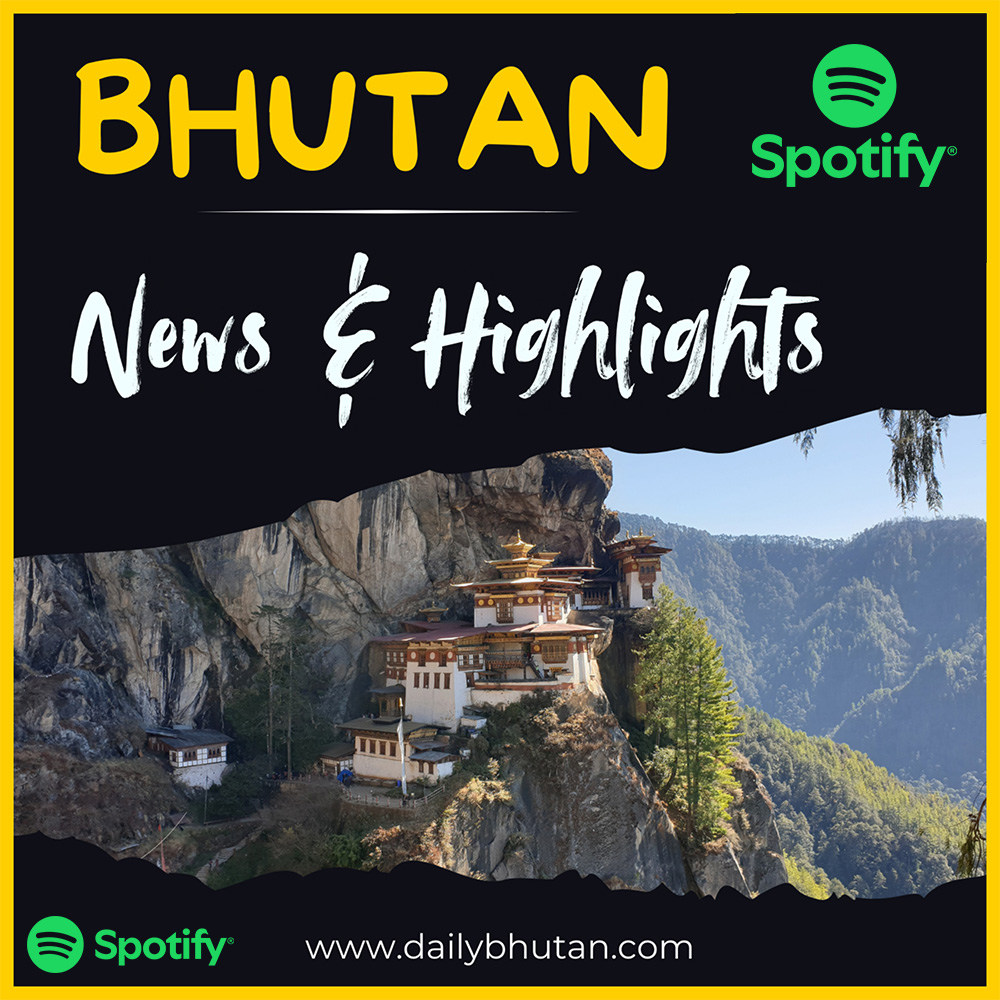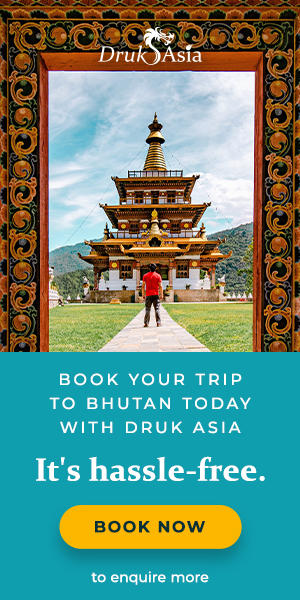Guru Rinpoche, the legendary saint who spread Buddhism in Bhutan
He was born from a lotus, fully enlightened. He went on to become the patron saint of Bhutan and established the Nyingma sect of Buddhism.
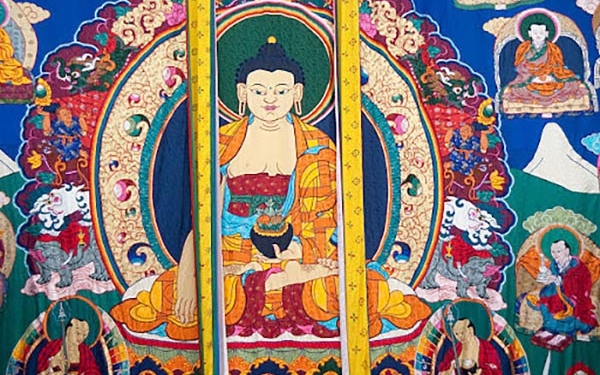
He goes by many names. The two common ones are Guru Rinpoche (Precious Guru) and Padmasambhava (born of a lotus).
While others achieved enlightenment slowly over time as they practised the teachings of the Buddha, Guru Rinpoche was special. He was incarnated as a fully enlightened being.
The Buddha predicted the coming of Guru Rinpoche
“Eight years after my mahaparinirvana, a remarkable being with the name Padmasambhava will appear in the centre of a lotus and reveal the highest teaching concerning the ultimate state of the true nature, bringing great benefit to all sentient beings.” — Buddha Shakyamuni, Mahayana Mahaparinirvana Sutra
The foretelling of Guru Rinpoche can be found in 19 different sutras and tantras.
At one point, the Buddha claimed that Guru Rinpoche would be even more enlightened than himself. Of course, the Buddha had already achieved the highest point of enlightenment, so this claim was merely a figure of speech. Yet, we can tell the reverence the Buddha attached to Guru Rinpoche.
Nonetheless, what could be unanimously agreed on was that Guru Rinpoche would appear in this world to help all sentient beings.
Guru Rinpoche was born of a lotus
Legend has it that Guru Rinpoche was born as an eight-year-old from a blossoming lotus in the Kingdom of Oddiyana. He was born fully enlightened, unlike the Buddha who only achieved enlightenment later in his life.
The moment he was born, he declared that he had been incarnated to complete the work of the Buddhas of the past, present, and future. Followers of Vajrayana Buddhism revere him as Avalokiteshvara (the embodiment of all the buddhas), and Amitabha (he who is infinite).
Legends About Guru Rinpoche
Guru Rinpoche taught the Princess Mandarava tantric mantras. Mandarava was the princess of the Kingdom of Zahor, which is near present-day Rewalsar in India. Mandarava’s father, the king of Zahor, did not like it. Next, he ordered for the two to be burnt alive.
Yet, to everyone’s surprise, the bonfire turned into a lake. When the smoke cleared, Guru Rinpoche and Princess Mandarava emerged from a lotus, untouched by the fire.
Impressed, the king gave the two his blessings. Guru Rinpoche and Princess Mandarava soon left for Tibet where the latter achieved enlightenment upon the completion of her studies. Princess Mandarava became the first of Guru Rinpoche’s five consorts.
The lake in Rewalsar remains a sacred place as it is believed that the incident took place there. Devotees have erected a shrine near the lake that is dedicated to the princess. In 2012, the devotees also built a 150-feet-tall statue of Guru Rinpoche at a small Buddhist settlement in Rewalsar.
The significance of Guru Rinpoche
Guru Rinpoche was instrumental in the establishment of Vajrayana Buddhism in Tibet in the 8th century.
There are three schools of Buddhism: Hinayana/Theravada, Mahayana, and Vajrayana.
While the Hinayana and Mahayana branches remained popular in India, Vajrayana slowly disappeared in the country between the 8th and 13th century. Vajrayana is the more ritualistic path of Buddhism.
Fortunately, Guru Rinpoche had taken the Vajrayana tradition to Tibet during his lifetime. Hence, the tradition not just survived, but even flourished. Thus, Guru Rinpoche is known as “the second Buddha”.
Throughout his years, Guru Rinpoche preserved his teachings and wisdom in the form of terma (hidden treasures) all over the Himalayas. Terma came in different forms: physical artefacts for one, but also data in the clouds, water, and surrounding environment. The treasures were to be discovered by tertons (treasure revealers) at a later time.
Guru Rinpoche in Bhutan
Guru Rinpoche first set foot in Bhutan in 810 A.D.
At that time, there was fighting between the Indian King Sindhu and a rival king named Naochhe. As fighting continued, King Naochhe killed King Sindhu’s son and 16 attendants. This enraged King Sindhu.
Next, King Sindhu defiled the abode of the deity Shelging Kharpo. The deity, in response to the defilement, turned the sky black and stole the king’s lifeforce.
The king was on the brink of death when he invited Guru Rinpoche to Bhutan to save him. Guru Rinpoche arrived in Bhutan, subdued the deity, and saved the king.
Later, Guru Rinpoche oversaw the construction of monasteries in the Paro valley and set up headquarters in Bumthang. Thus, he was responsible for the spread of Buddhism in Bhutan, becoming the patron saint of the country.
Guru Rinpoche’s greatest legacy
Arguably, Guru Rinpoche’s greatest legacy was establishing the Nyingma sect (also known as the Red Hat sect), one of the oldest of the four schools of Tibetan Buddhism.
According to the Testament of Ba, which is the earliest record of Buddhism in Tibet, Guru Rinpoche was requested to translate Buddhist texts into Tibetan and promote Buddhism in the area.
With a team of 25 disciples, 108 translators, and Santaraksita (the abbot of Nalanda), Guru Rinpoche translated a number of Buddhist texts to Tibetan. The project took many years. His efforts earned him the title of “Buddha of the Vajrayana”.
He refuted the negative impression people had of the tantra. He promoted rituals as a means to achieve moksha, which means liberation from the cycle of death. Hence, he is known for promoting tantra in Bhutan.
What are Guru Rinpoche’s eight manifestations?
At different points of his life, Guru Rinpoche had assumed different principal forms. His eight manifestations are:
1. Guru Padmasambhava, ‘Lotus-born’
2. Guru Tsokye Dorje, ‘Lake-born Vajra’
3. Guru Shakya Senge, ‘Lion of the Shakyas’
4. Guru Nyima Ozer, ‘Rays of the Sun’
5. Guru Loden Chokse, ‘Wise Seeker of the Sublime’
6. Guru Pema Gyalpo, ‘The Lotus King’
7. Guru Senge Dradrok, ‘The Lion’s Roar’
8. Guru Dorje Drolo, ‘Wild Wrathful Vajra’
Guru Padmasambhava, ‘Lotus-born’
Also known as Guru Pema Jungne. He is the saviour who taught dharma to the people, portrayed sitting on a lotus, dressed in the three robes of a monk. In his right hand, he holds the diamond sceptre of love and the yogi’s skull bowl in his left hand.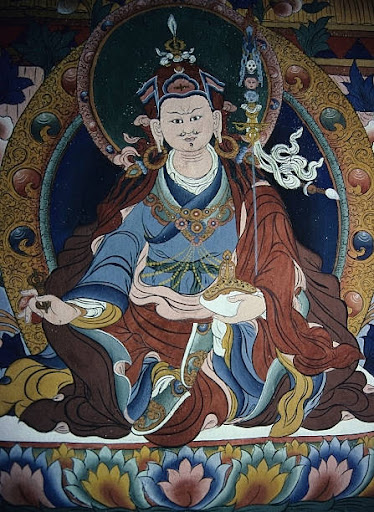
-
Guru Tsokye Dorje, ‘Lake-born Vajra’
In this form, Guru Rinpoche is peaceful and holds a vajra to his heart. A vajra is a type of weapon.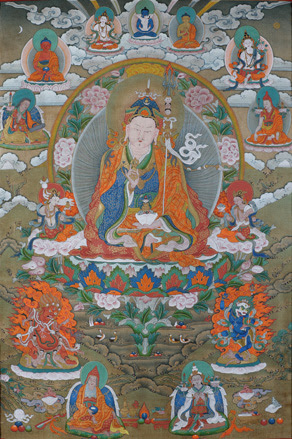 Picture credit: Guru Tsokye Dorje @ Rigpa Shedra
Picture credit: Guru Tsokye Dorje @ Rigpa Shedra
-
Guru Shakya Senge, ‘Lion of the Shakyas’
As Guru Shakya Senge, he is depicted as the Buddha in monk robes. In his left hand are an alms bowl and a vajra in his right hand.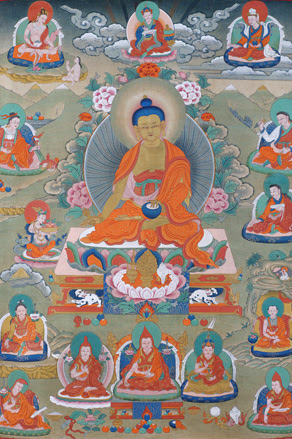 Picture credit: Guru Shakya Senge @ Rigpa Shedra
Picture credit: Guru Shakya Senge @ Rigpa Shedra
-
Guru Nyima Ozer, ‘Rays of the Sun’
Guru Rinpoche is featured as siddhas, who are skilled practitioners. Picture credit: Guru Nyima Ozer @ Rigpa Shedra
Picture credit: Guru Nyima Ozer @ Rigpa Shedra
-
Guru Loden Chokse, ‘Wise Seeker of the Sublime’
In this manifestation, Guru Rinpoche embodies his wisdom. He can master a teaching with a single glance.
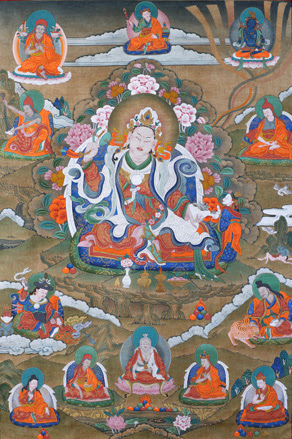 Picture credit: Guru Loden Chokse @ Rigpa Shedra
Picture credit: Guru Loden Chokse @ Rigpa Shedra
-
Guru Pema Gyalpo, ‘The Lotus King’
He looks like a crowned prince or king. Picture credit: Guru Pema Gyalpo @ Rigpa Shedra
Picture credit: Guru Pema Gyalpo @ Rigpa Shedra
-
Guru Senge Dradrok, ‘The Lion’s Roar’
Guru Senge Dradrok defeated 500 deviants in a debate. He reversed their magic with a wrathful mantra.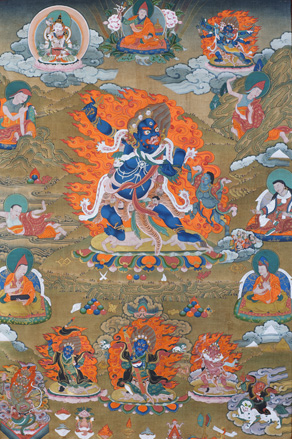 Picture credit: Guru Senge Dradrok @ Rigpa Shedra
Picture credit: Guru Senge Dradrok @ Rigpa Shedra
-
Guru Dorje Drolo, ‘Wild Wrathful Vajra’
This is the form in which Guru Rinpoche rode to the famous Tiger’s Nest. He is wrathful and riding on a pregnant tigress, which represents that he has overcome all fears.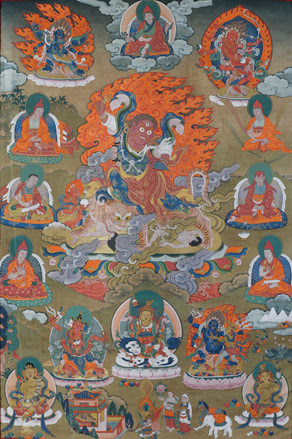 Picture credit: Guru Dorje Drolo @ Rigpa Shedra
Picture credit: Guru Dorje Drolo @ Rigpa Shedra
The Bhutan we know and love would not be the same without Guru Rinpoche. His influence can be found in every corner of the country. One way to celebrate Guru Rinpoche is by attending a tsechu. A tsechu is a religious festival held on the 10th day of various months in the Bhutanese calendar to honour Guru Rinpoche.
At the end of the tsechu, you will even get to witness the unfurling of a thongdrel, which is a giant scroll depicting the likeness of Guru Rinpoche. The Bhutanese believe that looking at the thongdrel can help you accumulate merits. We could all use some extra merits, don’t you think?

